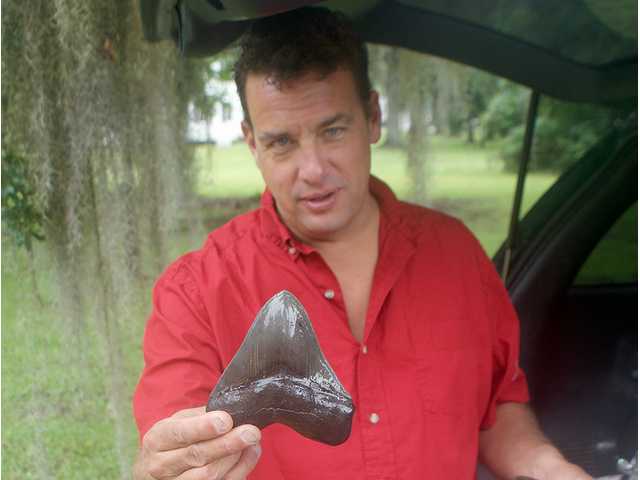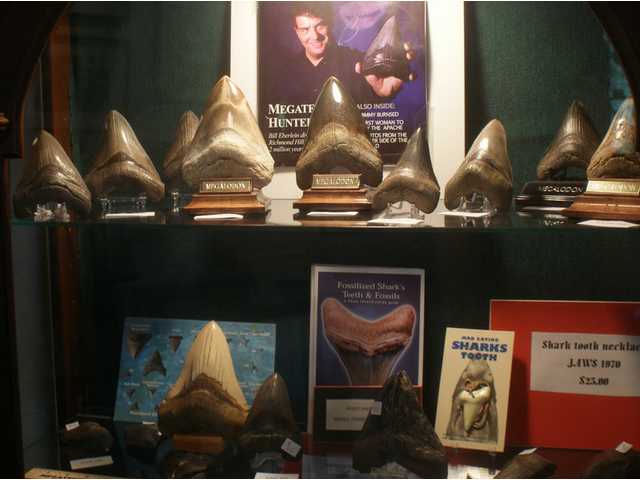Originally posted on the Coastal Courier by Lauren Hunsberger, staff writer
Updated: July 8, 2009 10:31 a.m.
Name: Bill Eberlein
Occupation: Instructor at Savannah Tech and Premier Systems and Training, Inc. in Savannah
Hobby: Fossil hunting — specifically, megalodon teeth, fossils that experts date back two million years ago.
How did you get started diving for fossils in South Georgia? “I started diving 25 years ago in Erie, Pa., and we used to dive Lake Erie for ship wrecks. In 1999 I was hired by Gulfstream in the IT department and came down here thinking I would be diving in the ocean. Then I met a guy who was an engineer at Gulfstream who said he dove for shark teeth in the rivers. The first thing I thought was, ‘Sharks’ teeth in the rivers?’ And then I was thinking like the little tiny sharks’ teeth, but he brought one [a megalodon tooth] in and I thought, ‘I’d like to find one of those.’ Then I went out and got hooked on it.”
What exactly is a megalodon shark? “It’s a shark that was about 70 feet long and they say that the megalodon shark was probably the size of a large whale today. So think of what a large whale is like, and imagine it’s a shark.”
What did they eat? “They think they ate giant sperm whales.”
When you’re underwater in the rivers around here, where the visibility is low, how do you distinguish a fossil or tooth from a rock or piece of wood when you can’t see it? “I’ve been doing this for years and, like today, I was digging real deep into the mud, and if I just touch a root (of a tooth) I know that shape instinctively. I wear gloves a little thicker than yellow dishwashing gloves and as soon as you touch a blade with that enamel, it’s so slick compared to everything else down there … I’ve found thousands of these over the years so you just know the feel of them.”
Is it scary diving in the depths of the murky water? “There are times where you get a little apprehensive. The thing that always scared me more than anything else, it’s not the sharks or the alligators, it’s the sting rays because they’re down there, buried. So you grab hold of one and all of a sudden, it comes out fluttering up and you see their tails flipping around and even if they hit you in the arm, it’s so painful and the bacteria could get in there.”
You dive mainly in local rivers. What are some of your favorite spots for finding teeth? “You know it’s funny because the whole area is covered. If you can get down 40 feet, the whole area is covered with the fossils. So you tend to just move around a lot. There are some real nice spots near Richmond Hill. There are some spots down here in Liberty County. Just for convenience sake, I dive in both areas. So, there’s not one spot in particular. There are some near the Intercoastal and near St. Catherines, too.”
Are people amazed when you tell them you find fossils from 2 million years ago in local rivers? “Yeah, they are. And in fact, I go to this dive shop in Savannah and for the first two years, a few of the divers would laugh and they’d go, ‘Wait a minute, you dive in the rivers for shark’s teeth?’ But it’s just so much fun. But yeah, people are amazed.”
Is there a pretty large group of people who collect these? “Yeah. If you go on eBay there will be hundreds for sale. I’ve sent teeth to people all over Europe and Japan, China and Taiwan. I just sent one to Malta. I still don’t know where that country is.”
Do you have any advice for anyone who is interested in doing this as a hobby? “The diving is a little tricky. I was diving 15 years before I started doing this. I was trained in Pennsylvania with a search and recovery team with the sheriff’s department. It’s tricky because you’re doing all things you normally shouldn’t be doing. You’re diving in bad visibility, you’re diving in strong currents and you’re diving alone … so there’re a lot of hazards.
“I guess my advice for someone who really wants to do this is to get really comfortable diving to the point where you know all your gear without seeing it. There’re a lot of times when I can’t even see my air gauge to see how much air I have left.”
Among other fossils collections, you also have a large collection of pectin shells. What is the significance of the shells? “They’re 2 million years old and they’re just scallop-type shells. You don’t find them all over. There are about three spots where you can find these and they’re mixed in with the sharks’ teeth. So, when you start thinking about the layers of the Earth, they find these shells in the same layers where the sharks’ teeth are, so that’s how they date them.”
To see a collection of Bill Eberlein’s Megalodon teeth, visit The Plunder Box in the IGA Plaza at 192 Butler Ave. Midway GA.
or go to www.megateeth.com.




